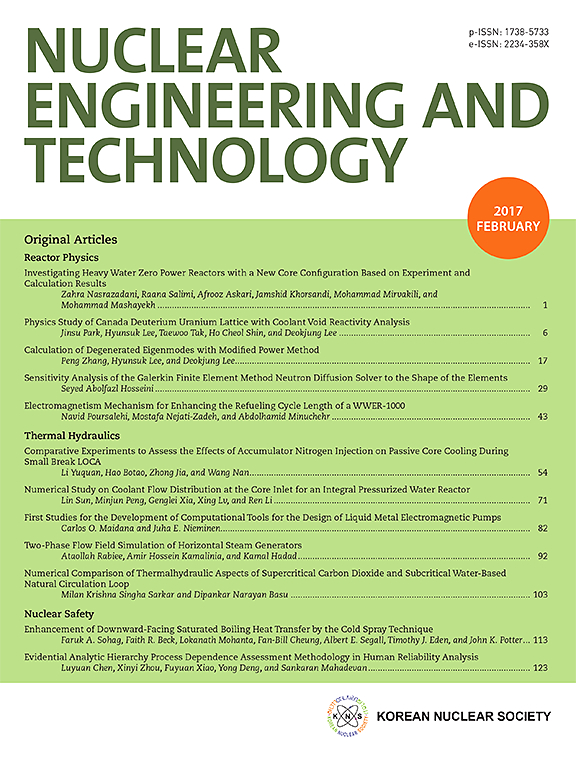Development of a test task for coupled neutronic and thermal-hydraulic analysis of LFR fuel cell
IF 2.6
3区 工程技术
Q1 NUCLEAR SCIENCE & TECHNOLOGY
引用次数: 0
Abstract
In the absence of operational experience with Generation IV reactors and limited experimental data, developing test tasks is crucial for ensuring the safety and reliability of novel reactor designs. This study presents a test task for coupled neutronic and thermal-hydraulic analysis of a lead-cooled fast reactor (LFR) fuel unit cell in the BREST-OD-300 core. Neutronic simulations using the Monte Carlo-based MCU-FR code identified an optimal axial discretization of 44 layers to reduce uncertainties in power density distribution. The resulting axial power density profiles were used in CFD thermal-hydraulic modeling with LOGOS software to assess the impact of different turbulent Prandtl number correlations on axial temperature profiles. The study shows that the choice of turbulent Prandtl number introduces up to 1% model-uncertainty in temperature predictions due to differences in turbulence modeling assumptions. In addition, the application of fully coupled neutronic and thermal-hydraulic feedback results in a deviation of above 2% in average fuel temperature compared to the non-coupled solution. This test task is aimed at enhancing the accuracy of reactor simulations and safety assessments while contributing to the development of a benchmark suite for LFR reactors, supporting cross-verification of computational tools and methods.
LFR燃料电池中子-热-水力耦合分析测试任务的开发
由于缺乏第四代反应堆的运行经验和有限的实验数据,开发测试任务对于确保新型反应堆设计的安全性和可靠性至关重要。本研究提出了在BREST-OD-300堆芯中对铅冷快堆(LFR)燃料单元电池进行中子和热工耦合分析的测试任务。利用蒙特卡罗的MCU-FR代码进行中子模拟,确定了44层的最佳轴向离散化,以减少功率密度分布的不确定性。利用所得的轴向功率密度分布,利用LOGOS软件进行CFD热-水力建模,以评估不同湍流普朗特数相关性对轴向温度分布的影响。研究表明,湍流普朗特数的选择在温度预测中引入了高达1%的模型不确定性,这是由于湍流建模假设的差异。此外,与非耦合解决方案相比,完全耦合的中子和热压反馈的应用导致平均燃料温度偏差超过2%。该测试任务旨在提高反应堆模拟和安全评估的准确性,同时为LFR反应堆基准套件的开发做出贡献,支持计算工具和方法的交叉验证。
本文章由计算机程序翻译,如有差异,请以英文原文为准。
求助全文
约1分钟内获得全文
求助全文
来源期刊

Nuclear Engineering and Technology
工程技术-核科学技术
CiteScore
4.80
自引率
7.40%
发文量
431
审稿时长
3.5 months
期刊介绍:
Nuclear Engineering and Technology (NET), an international journal of the Korean Nuclear Society (KNS), publishes peer-reviewed papers on original research, ideas and developments in all areas of the field of nuclear science and technology. NET bimonthly publishes original articles, reviews, and technical notes. The journal is listed in the Science Citation Index Expanded (SCIE) of Thomson Reuters.
NET covers all fields for peaceful utilization of nuclear energy and radiation as follows:
1) Reactor Physics
2) Thermal Hydraulics
3) Nuclear Safety
4) Nuclear I&C
5) Nuclear Physics, Fusion, and Laser Technology
6) Nuclear Fuel Cycle and Radioactive Waste Management
7) Nuclear Fuel and Reactor Materials
8) Radiation Application
9) Radiation Protection
10) Nuclear Structural Analysis and Plant Management & Maintenance
11) Nuclear Policy, Economics, and Human Resource Development
 求助内容:
求助内容: 应助结果提醒方式:
应助结果提醒方式:


